Chapter 6
Soil Water
Many ancient civilizations left evidence that it was well understood how vital water was to the survival of their cultures. Nomadic tribes followed the seasonal rainfall patterns that affected the growth of forages for their grazing animals and of edible plants for their own consumption. Some of the earliest public works projects involved drainage and irrigation of lands to enhance crop production. The eventual collapse of some of these ancient civilizations has been attributed to poor management of water resources. Human reliance on a sufficient and timely supply of water for food and fiber production is no less critical today.
Water stored in the soil does several things. First, it is essential to plant growth. Nutrients move within the soil solution and are absorbed (taken up) from it by plants through the roots (see Chapter 8). Second, it is essential to the microorganisms that live in the soil and decompose organic matter and recycle plant nutrients (see Chapter 4). Third, it is important in the weathering process and soil formation by accelerating the breakdown of rocks and minerals to form soil and release plant nutrients (see Chapter 2). Fourth, water also plays a role in moderation of soil temperatures (Chapter 7). Fifth, water serves as an active factor in soil formation by translocating fine particles downward and dissolved substances both downward and upward.
Water in the soil influences the timing of many farming operations, such as when to till, when to plant, and when and how to apply herbicides and/or fertilizers. Soil water influences the choice of crops to be grown. In areas where rainfall and soil water are sufficient, corn may be grown. In areas with less rainfall and/or more evaporation, there is less soil water available, and a cereal crop or grain sorghum (milo) is more likely to be selected by farmers. To effectively manage available water resources, it is important to understand the processes of water movement in soils and uptake by plants.
Hydrologic Cycle
Hydrology is the study of the movement of water on the earth. The hydrologic cycle (Fig. 6.1) is used to summarize all the processes involving water in the environment. When the hydrologic cycle is considered on a global scale, it is common to begin with evaporation of water from the oceans. Evaporation also occurs from the land, and a small amount of water vapor comes directly from snow and ice in alpine and Polar Regions through sublimation (transformation of ice directly to water vapor). Water vapor in the atmosphere forms clouds and the water falls to earth in precipitation (rain, snow, sleet, and hail). Precipitation that falls on the ocean can be evaporated again. Snow that falls in polar or mountainous regions may be stored for decades or centuries before it melts.
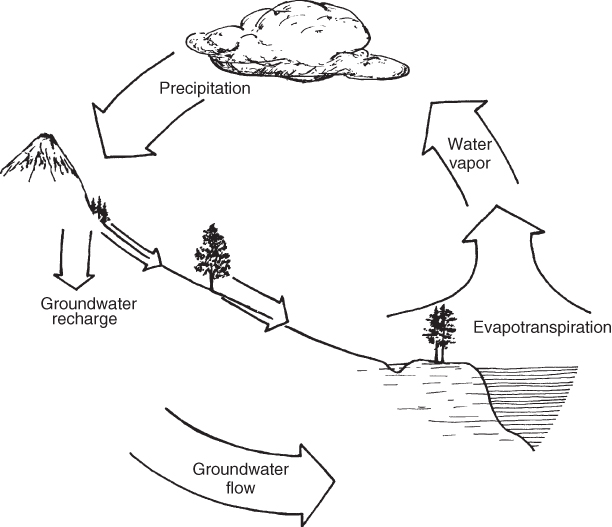
Figure 6.1 The hydrologic cycle describes the flow of water in the environment.
Some of the precipitation that falls on land is intercepted by vegetation and evaporates back to the atmosphere but most of it reaches the soil surface.
Precipitation that reaches the soil can either enter the soil or run off the land to a surface water body (stream, marsh, or lake). Surface water eventually evaporates, seeps farther into the earth, or flows back to the oceans, where it can evaporate and start the cycle again. Water that enters the soil is of most importance to plant growth. This water can evaporate from the soil surface, be absorbed by plant roots to be utilized by the plant or transpired (evaporate from leaves), or pass through and out of the root zone to become part of the groundwater.
The global hydrologic cycle is very complex and involves processes that occur on large scales (precipitation) and over long periods of time (melting of glaciers). Nonetheless, parts of the hydrologic cycle have strong implications for food and fiber production. For instance, in several areas of the world, water from melting snow and ice is captured in reservoirs and used to irrigate crops sometimes hundreds of miles (kilometers) away.
Soil Water Budget
Although soil water is just one component of the hydrologic cycle, it represents the crucial reservoir of water for the growth of most plants. An easy way to monitor water in soils is to consider the soil's water budget. Just as a person may have a financial budget with inputs (income, investments, etc.) and outputs (food, clothing, shelter, etc.), the soil has a water budget. In agricultural settings there are two inputs: precipitation and irrigation. Water from precipitation and/or irrigation can either move into the soil (infiltration), or it can run across the soil surface to a stream, marsh, or lake (runoff).
What happens to water after it enters the soil? It can be stored in the root zone for future use by plants or move through the soil and out of the root zone (percolation) and eventually to groundwater. It may also evaporate, either directly from the soil or from plant leaves (transpiration) after being absorbed by roots. Thus, the soil's stored water is the difference between the sum of all inputs and the sum of all outputs. The water budget has two inputs (precipitation and irrigation) and three outputs (runoff, evaporation, and percolation) (Fig. 6.2).
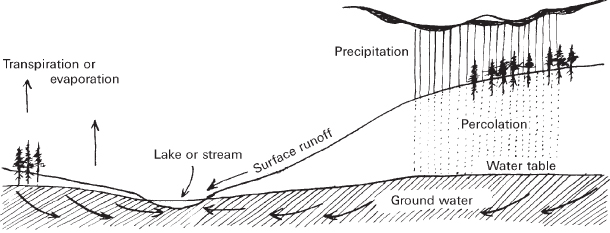
Figure 6.2 Water that enters the soil may percolate or evaporate or it may be transpired or stored.
The water budget can be put in equation form:

where S is the amount of stored water, P is precipitation, I is irrigation, R is runoff, E is evaporation and transpiration, and D is percolation. Each term in the water budget equation would have linear units of measurement such as inches (millimeters). Typically, water budget analyses are completed for months or years so managers can analyze trends in each term and consider options to optimize water use.
The amount of water that ends up in each term is partly determined by climate and partly by properties of the soil and the requirements of the plants growing in the soil. Of course, humans also have the opportunity to manage the movement of water by choosing which crops to plant, when and how much to irrigate, types of tillage and residue management practices to follow, or to provide drainage of excess water.
Infiltration and Runoff
Precipitation or irrigation that reaches the soil surface is partitioned between infiltration and runoff. The rate of infiltration varies with the texture and physical condition (structure and porosity) at the soil surface. Sandy soil, because of its relatively large pore size, has a higher infiltration rate than clay soil with its smaller pore size (Fig. 6.3). If the physical condition of the soil is poor, the infiltration rate is reduced. A sandy soil may have an infiltration rate greater than 1 in. (2.5 cm) per h, whereas some clayey soils require more than 12 h for 1 in. (2.5 cm) of water to infiltrate.

Figure 6.3 Soils with large pore spaces, such as sandy soils and well-granulated types, usually have high infiltration and percolation rates, whereas those that have small pore spaces or are in poor physical condition have low infiltration and percolation rates. Runoff occurs if the rate of rainfall exceeds the water infiltration rate.
Figure 6.4 gives an indication of the rates of runoff and infiltration for a hypothetical rainstorm. The rate of infiltration needs to be known when designing a drainage or irrigation system. One way to estimate infiltration would be to observe how long it takes before water starts to run off (if it ever does) during a rainstorm. If the rate of water infiltration into soil is less than the rate at which rain falls, water accumulates on the soil surface. If enough water accumulates to fill the small depressions at the soil surface, runoff begins. If the amount of rainfall and the duration of the storm are known, then the infiltration rate can be estimated.
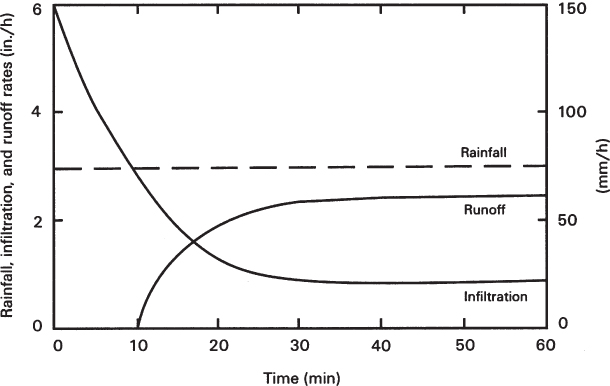
Figure 6.4 Runoff and infiltration for a 1.5-in. (38-mm) rainfall in 1 h. The infiltration rate decreases as the soil wets until runoff begins after 10 min. Late in the storm, the runoff and infiltration rates are steady. Runoff would have begun later and been less if the soil had a higher infiltration rate.
As runoff water flows downslope across the land surface, it gathers momentum and picks up soil particles, which results in soil erosion. It is generally desirable to hold as much of the rain as possible where it falls to provide water for crops and to protect the soil from erosion. On some soils in humid regions, however, it is necessary to encourage runoff through a surface drainage system that prevents the soil from becoming waterlogged. It is impossible to avoid all erosion, but it is important for it to be minimized. Soil erosion will be discussed further in Chapter 10.
A farmer can influence the infiltration rate of a soil by keeping a protective vegetative cover on the surface and by maintaining good soil structure, both of which help conserve water and soil. By keeping the soil in good physical condition, the topsoil becomes full of “crumbs,” which are stable, spongy aggregates. With this condition of the soil, water moves easily into and through the soil. Such aggregates form when adequate organic matter is present and excessive tillage is avoided. The farmer who depletes the soil of organic matter by removing crops without returning plant residues or manure is likely to decrease the infiltration rate. When raindrops strike exposed soil, especially without the spongy aggregates, the soil is beaten to a paste and a seal forms on the surface. The soil surface then tends to shed water like a roof.
When a sealed-off surface becomes dry, it forms a brittle crust that can inhibit emergence of seedlings. Seedlings such as those of beans and potatoes are strong enough to break through, lifting pieces of the crust like so many trapdoors opened from below. But seedlings of small-seed crops such as oats and even the larger seedlings such as corn may perish without ever emerging (Fig. 6.5). Sometimes farmers have to break this crust with light tillage after planting the crop, but this may be only partially successful.
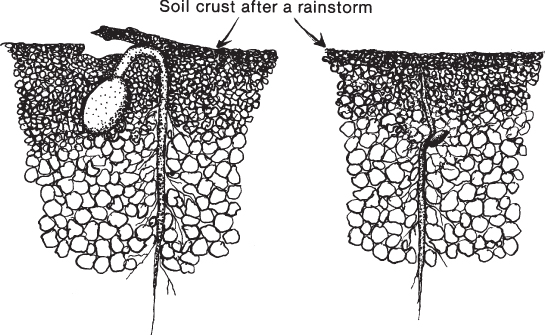
Figure 6.5 If a plant seedling is not strong enough to lift the soil crust, it dies.
Evaporation
Evaporation is the transformation of water from liquid to vapor regulated by solar energy, wind movement, and humidity. Soil water can evaporate directly from the soil or it can be absorbed by roots and evaporate from stomates on the leaves of plants. The process of evaporation from stomates is called transpiration. Evaporation from soil and transpiration by plants may be combined and called evapotranspiration (Fig. 6.6).
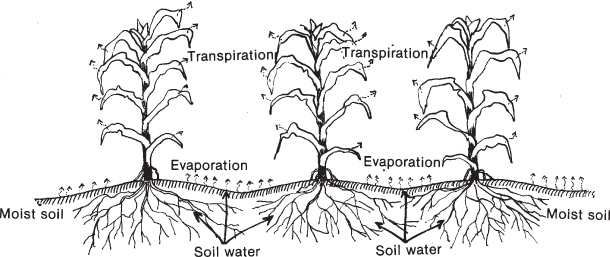
Figure 6.6 Soil water returns to the atmosphere by evaporation from the soil surface and by transpiration from plant leaves.
In many temperate and drier regions, at least half the water lost from farmland is by evaporation. Therefore, farming practices are often designed to reduce this loss and conserve moisture. One effective practice is to leave the plant residue from the previous crop on the soil surface. These crop residues reduce evaporation by shading the soil and blocking water vapor movement.
In small plots of high-value crops, mulches are often used to hold the soil water for plants and thus reduce evaporation (Fig. 6.7). Many kinds of mulches have been used: straw, corncobs, gravel, and plastic. All can be quite effective. The selection of one type of mulch over another depends on the specific use and availability of the material. Organic materials such as straw are preferable in situations where the mulch can be incorporated into the soil after each crop. Sand and gravel have the advantage of allowing a higher percentage of small rains to infiltrate into the soil rather than being absorbed by the mulch. This can be an advantage around fruit trees and ornamental plantings.
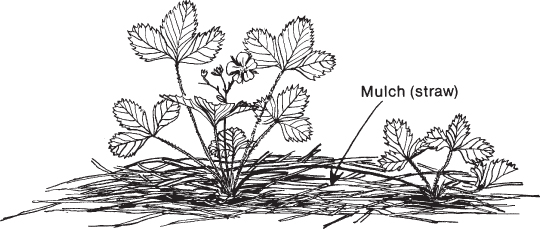
Figure 6.7 A mulch helps prevent evaporation of water from the soil.
The use of black plastic as a mulch is popular in vegetable production because it effectively controls both weeds and evaporation. A variation in this practice is to form plastic or tar paper into a shallow cone around the base of a tree or shrub and cover it with a few inches of gravel. This allows rainwater to enter the soil near the trunk and leaves no place for weeds or grass to grow in hard-to-mow places (Fig. 6.8).

Figure 6.8 Black plastic or tar paper controls weeds and evaporation.
Farmers in dry areas where wheat is a leading crop utilize the principle of mulching by leaving much of the plant residue on the soil surface when tilling after harvest. Creating a dust mulch by frequent tillage of fallow land is now often discouraged because it has been found that little water is conserved by this practice and that soil may be left susceptible to severe wind erosion.
Percolation
In 1856, an engineer named Henry Darcy was the first to describe how water moves through a saturated soil (all pores filled with water). He developed his theory by observing the flow through a sand filter used to purify water in the French city of Dijon, famous for the production of mustard.
The force of gravity causes water to move downward through the soil, particularly in larger pores. Gravitational water percolates until it is adsorbed by drier soil below or it reaches the water table. The water table is the level in porous subsurface materials below which all pores are filled with water. This may be within the surface soil, in buried sediments, or in the deep bedrock. Groundwater is the water below the water table. The amount of water that percolates through the root zone to groundwater is referred to as groundwater recharge. The water table surface has a slight slope (much less undulating compared to land slopes) allowing the water to flow laterally below ground. Porous soil or rock layers that are saturated can be important sources of well water. Such layers are called aquifers.
As water moves downward through the soil to reach the water table and the ground water, it may encounter a soil layer that restricts downward movement causing water to build up and form a perched water table. If the perched water table is within the root zone, plant roots growing in this zone may be deprived of oxygen, thus impacting plant growth.
In a flat area, water flow in a uniform soil will be primarily downward. On steep slopes or when there is a gentle slope with a restricting or more conductive layer in the soil (like a layer of clay or gravel), water movement may still be downward but some water may also move downslope or laterally. Lateral water flow in mountainous areas may come to the surface again as discharge from flowing springs. In all cases, plant uptake draws water out of the soil, altering water movement in the soil near the roots.
Wetlands, lakes, and streams in humid regions are often places where the water table comes to the surface and groundwater discharge takes place. Wetlands in drier regions, however, are often groundwater recharge areas, where surface runoff collects and infiltration occurs. Thus, wetlands in these areas serve an important role in replenishing aquifers.
Soil Water Storage and Movement
Two forces impact soil water storage and movement. They are; (1) gravity and (2) attraction of soil particles for water. When soil is saturated with moisture, gravity is the dominant force in moving water in large pores deeper into the soil. At the same time that gravity is pulling water downward, the soil particles are attracting water in all directions by the forces of adhesion and cohesion. Adhesion is the attraction of a surface for water (e.g., the surface of the soil particle), and this force is quite strong. Cohesion is the attraction of one water molecule for another. The two forces combine so that water is held within small pores between soil particles. Because one of the forces is the attraction a soil particle surface has for water, it follows that a soil with very small particles and more surface area such as a clay attracts and holds more water than a soil with large particles and less surface area such as sand.
When a soil dries, adhesive forces begin to dominate, and the water remaining in films is held very close to the soil particles with greater force due to the surface attraction for water. Consequently, water movement is very slow. Water movement in unsaturated soils involves a complex combination of gravity, relative amount of water, and adhesive/cohesive forces. It was not until 1907 that an American, Edgar Buckingham, was able to accurately describe water flow in unsaturated soils.
As a plant root absorbs water, it takes some from the film surrounding the adjacent soil particle. Due to cohesion and adhesion, water moves from particles with thicker films to particles with thinner films that are next to the roots. This is called capillary movement (Fig. 6.9). Capillary water may move to the roots from any direction—up, down, or laterally. An important fact is that water moves in the soil toward roots to provide plants with water. Some essential nutrients can also move with the water. Capillary movement, however, is normally very slow in soil, so plants must continually extend their roots into moist pores to absorb water. The soil thus has a critical role in agriculture as it acts as a storehouse of water for plants to use until the next rain or irrigation.
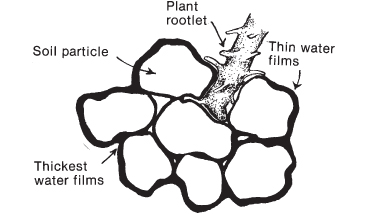
Figure 6.9 Water moves from soil particles with the thickest water films to soil with the thinnest. As the plant root absorbs moisture, water tends to move toward it (capillary movement). Plant roots also grow and extend into zones with more moisture.
Water Use by Plants
Water is essential to all forms of life—both plants and animals. Some plants have low water requirements and are called xerophytes (xero means little or none and “phytes” from the word phyto, which means plant). Some have high water requirements and are called hydrophytes (hydro means water). Plants with moderate water needs are called mesophytes (meso means intermediate).
Plants need water to form certain compounds. For example, six parts of water are required for each simple sugar produced. The process of forming simple sugars, called photosynthesis, involves the splitting of water (H2O) into hydrogen and oxygen. The hydrogen combines with carbon dioxide (CO2) to form sugars, and the oxygen is discharged into the atmosphere through openings called stomates in the leaves of plants.
Much of the water stored in the soil is used by a plant. The amount of water stored in the soil and the amount available to plants vary with the texture and structure of the soil. When soil water content is near saturation and gravitational forces are dominant, most water in the soil is readily available to the plant.
The maximum amount of water in a soil held against the force of gravity is called the field capacity. As water is used by plants or evaporates, the water film around soil particles becomes thinner, is more tightly held by the particles, and is more difficult for the plant to absorb. Eventually, the attraction between the soil and the water is greater than the plant's ability to absorb it. This amount of water in a soil is called the wilting point because the plant can no longer absorb enough water to maintain transpiration and sustain life (Fig. 6.10).

Figure 6.10 The water films in A are thickest and the soil is nearly saturated; at B it is about at field capacity; and the thin films in C represent the wilting point.
Between these two points, the field capacity and the wilting point, water is available to the plant (Fig. 6.11). The amount that is available varies with soil texture (and physical condition). For example, a sandy soil (which has large particles and low surface area) may store about 1 in. of water per foot of soil depth (83 mm/m) and most of the water would be available to plants. A clay soil (which has small particles and high surface area) may hold 4 in. of water per foot of soil depth (333 mm/m), but because of the strong attraction of clay particles for water, only 1 in. of these 4 in. may be available for plant use. Soils with the greatest amount of available water are usually those with a loamy texture and good structure.

Figure 6.11 Soil water between field capacity and the wilting point is available to the plant.
Only a very small percentage of the water absorbed and utilized by a plant is for photosynthesis. Water's principal function is to transport nutrients and plant compounds in solution, either upward from the plant roots to the upper leaves or downward into lower leaves or the root system. Most of the water taken up by a plant eventually evaporates at the stomates (Fig. 6.12). Water lost from the plant due to evaporation from the stomates is called transpiration and, especially in hot weather, transpiration helps cool a plant. Less than 1% of the water absorbed by a plant is used in forming plant compounds; the rest is lost via transpiration.
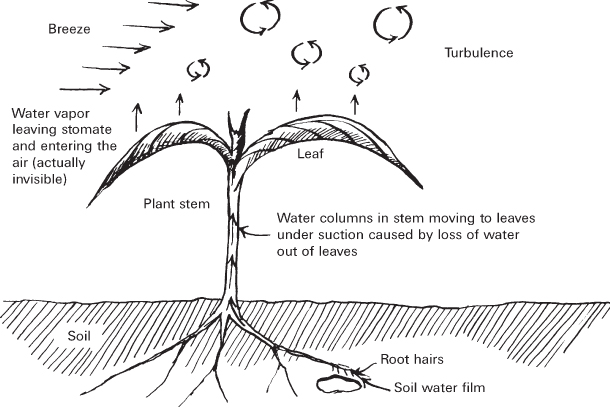
Figure 6.12 Water moves into the roots and through the plant primarily by capillary action.
A plant's water use efficiency is determined by measuring the amount of water required to produce a certain weight of dry plant tissue. It takes approximately 500 lb (225 kg) of water to produce 1 lb (0.45 kg) of wheat (foliage plus grain). Only 5 lb (2.25 kg), or 1% of this amount actually becomes part of the plant. Alfalfa uses more water, requiring about 850 lb (385 kg) of water per pound (0.45 kg) of dry matter; while grain sorghum, an efficient water user, may require less than 300 lb (135 kg) of water per pound (0.45 kg) of dry matter.
Drainage
It is a common occurrence in many regions of the world for the soil to contain too much water during rainy seasons of the year or during winter when evaporation is low. If the soil is waterlogged too long during the growing season, roots die from lack of oxygen or from accumulation of toxic compounds. To rid the soil of excess water, drainage systems have been installed on millions of acres (hectares) of land. Drainage systems can involve subsurface or surface practices or a combination of both. Remarkable increases in crop yields can occur when naturally wet soils are drained.
Subsurface drainage is the practice of burying a network of perforated pipes horizontally in the soil. The pipes intercept percolating water, or capture the water in a perched or true water table. The water entering the pipes moves laterally to a surface outlet such as a drainage ditch. Drain pipes or tiles were originally made of short sections of concrete or clay, but long lengths of flexible plastic tubing are now more popular. The tubing is installed at a depth of 2–6 ft. (0.6–1.8 m) and has a slight downward gradient to the surface outlet. Subsurface drainage functions only when the soil is saturated, so that water can flow from the large pores in the soil into the gaps between sections of clay or concrete tile or through holes in the plastic tubing and on along the tile or tubing to the outlet (Fig. 6.13).
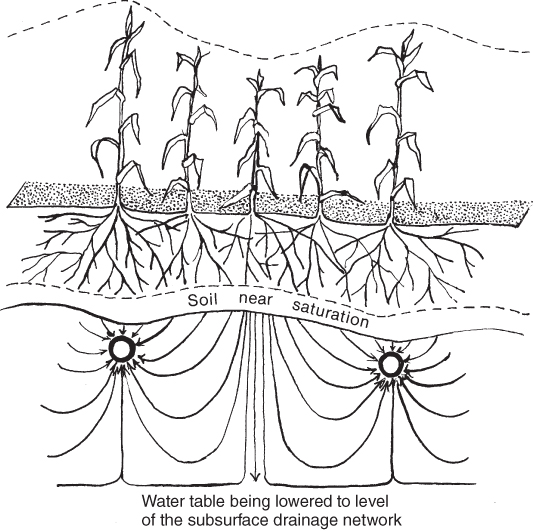
Figure 6.13 The water table can be lowered to the level of the subsurface drainage network.
In some cases, a vertical tube is installed from the subsurface drain to the soil surface to allow water ponded on the soil to enter the drain without percolating through the soil. These surface inlets or intakes are commonly found in areas with small depressions that fill with water during heavy rains or spring snowmelt.
Subsurface drainage can be installed in different patterns, depths, and spacing depending on land slope and location of the outlet (Fig. 6.14A–D). The random design (Fig. 6.14A) is used where there are isolated wet areas. Drain lines are run under each area with perhaps a surface inlet in the larger depressions. Pattern (Fig. 6.14B) and herringbone (Fig. 6.14C) drainage patterns involve uniform distances between multiple drain lines. The pattern used depends on slope of the land and desired depth of unsaturated soil. An interceptor drain (Fig. 6.14D) is used to intercept lateral flow down a slope that may be creating a wet spot.
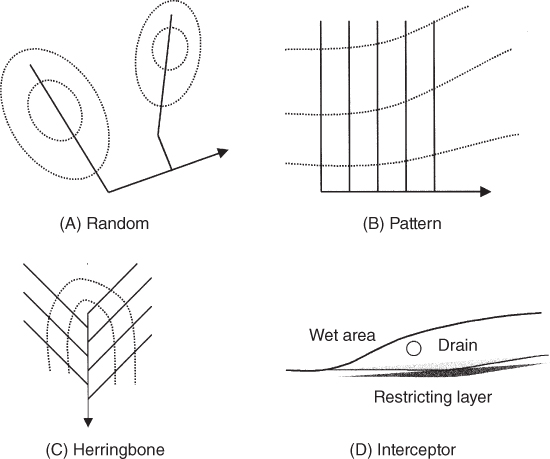
Figure 6.14 Different types of subsurface drainage systems.
Surface drainage involves digging channels in the soil and sometimes also shaping the land surface so water will run over the surface into the channels. Surface drainage is used on soils that have layers with low permeability or in very flat areas like the Red River Valley of North Dakota and Minnesota. In these areas, water either cannot move through the soil fast enough or the slope of the land is nearly flat for subsurface drains to flow effectively. Combination surface/subsurface drainage systems involve subsurface drains using surface drainage channels for their outlets.
To have an outlet for subsurface drains, some natural stream channels have been straightened and/or deepened (Fig. 6.15). This practice is called channelization, and is often criticized for impacting water quality and wildlife conservation. Draining wetlands that should be preserved for wildlife habitat or for water quality protection is often undesirable. In these cases, channelization is usually undesirable. However, on agricultural land that is in crops and pasture, channels can be beneficial to both agriculture and wildlife. When intermittent waterways are deepened, a permanent stream may be formed. As a result, fish thrive, and birds, mammals, and reptiles find an improved environment along the channel banks. Crops also flourish, and they too provide food and shelter for wildlife.

Figure 6.15 Channelization is needed to carry water from subsurface drains.
To help offset the loss of wetlands due to farmland drainage and channelization, artificial wetlands can be created. Shallow depressions are made in the soil in low-lying areas and wetland plant species are seeded or transplanted into the depression. Water from runoff or subsurface drains is directed into the wetland. The wetland may be designed to be flooded the entire year or only after spring snowmelt and large rainstorms. These constructed wetlands; (1) provide wildlife habitat, (2) may help reduce chemical and sediment transport to streams, and (3) increase groundwater recharge.
Irrigation
Since ancient times, various civilizations have utilized water from rivers and wells to ensure more reliable crop production. Today, about 17% of the World's cropland is irrigated. Because yields on irrigated land are usually high, irrigated cropland accounts for a disproportionately large part of crop production. In countries where rice is the staple diet, the people rely on irrigated agriculture for most of their food. Many of these countries have a monsoon climate where the annual rainfall is high but most rain falls during a few months and is followed by an extended period of limited rainfall. Even in the temperate regions, timely rains can be quite unpredictable from year to year so irrigation agriculture is common.
Different irrigation systems are used based on the crops being grown, the source and quality of water, and the level of technology available. Flood irrigation involves flooding the entire field with water from canals or pipes (see Fig. 6.16). Paddy rice production is an example of flood irrigation. A berm around the field contains the water and sometimes the plants are grown in rows on ridges with the water flowing between the rows. With sprinkler irrigation water is sprayed onto the crop from nozzles suspended above the canopy. Often the water source is a well and electricity or an engine is needed to pump the water and/or move the sprinklers. Sub-irrigation can be accomplished with small tubes buried in the soil through which water is pumped. Water seeps into the soil through emitters spaced along the tubing. Another type of sub-irrigation involves putting water back into subsurface drain tubes to re-wet soil in the root zone. Drip irrigation utilizes small tubes on the soil surface with drippers or micro-sprinklers placed near the plants. Water is pumped through the tubes and the amount of water applied depends on the length of time and the number and size of the drippers or micro-sprinklers. Drip irrigation is most often used with high value crops and where there is a very limited availability of water for irrigation (see Fig. 6.16).

Figure 6.16 Examples of types of irrigation systems: (A) surface or flood, (B) sprinkler, (C) sub-irrigation, and (D) drip. Photos courtesy of USDA NRCS.
The first two conditions to consider for irrigation feasibility are a source of water and adequate soil drainage. The quality of irrigation water is important because it may have long-term impacts on soil properties. The two common qualities of irrigation water that are of concern are high total salt content and a high-concentration of sodium. In some cases, other ions such as boron, lithium, and selenium may be present at toxic levels in the proposed water source. Sometimes special water-utilization techniques can be employed to enable the use of water of marginal quality. In some instances, irrigation water may contain beneficial ions. Nitrate nitrogen (NO3−) might be present in irrigation water at high concentrations, such as in the Platte River valley of Nebraska. In these instances, a credit should be given for the amount of nitrogen applied during irrigation.
All irrigation water contains salt, and when irrigation water evaporates, the salts tend to accumulate and might negatively impact plant growth. This is when the internal drainage of the soil becomes important. If salts accumulate, the only way to remove them is by applying more water. When this water moves downward, the salts dissolve and move with the water. This is called leaching. Water used for leaching can be either from rainfall or irrigation. The removal of salt from irrigated soil may create other problems. If internal drainage of the soil is good, salts can be leached down through the root zone and either accumulate there or continue to move downward. If soil drainage is poor, salts can move off the soil surface as water moves across it (as in rice production). In some soils with poor internal drainage, subsurface drainage systems may be installed. As water moves through the soil into the drainage system, salts move with it (such as in the Imperial Valley of California). Regardless, the salt concentration in the water increases as it moves across or through the soil. The water coming out may contain three to four times the salt content compared to the water going into the field.
Discharging water with high salt content into the drainage system of an area can create problems for those downstream from the point of discharge. If salt concentration is too high, it can be detrimental to human and livestock consumption or for reuse as irrigation water for crop production.
If sodium concentration is high in the irrigation water, the soil will develop a high exchangeable sodium level. Sodium is attracted to a lesser extent to colloidal surfaces than is Ca2+, but it takes only about 15% Na+ on the exchange complex to cause a dispersal of clay particles. Soils with high exchangeable sodium will normally develop surface crusts and soil aggregates will disperse. These conditions decrease the rate at which water moves through the soil, which interferes with drainage and salinity control. Scientists at the U.S. Salinity Laboratory developed the sodium adsorption ratio (SAR) to characterize the sodium status of irrigation water and soil solutions:

where the concentrations of Na+, Ca2+, and Mg2+ are expressed as moles of charge/L. SAR values are not used alone but rather with other measures of salinity or sodicity. A SAR below 13–15 for a soil extract is generally considered acceptable.
About three-quarters of the irrigation water in the United States comes from surface waters such as rivers and reservoirs where rainwater and/or snowmelt have been impounded. The remaining quarter comes from underground aquifers. Some wells tap shallow aquifers that are replenished by precipitation annually, such as in the Central Sands of Wisconsin, but others “mine” deep water that was trapped in aquifers thousands of years ago and is not being replenished to an appreciable degree. This situation, referred to as overdraft, is occurring in parts of the High Plains of Texas, where the water table is dropping. This potential problem exists where the Ogallala aquifer, which reaches from South Dakota to Texas, has been supplying irrigation water since the 1930s. The solution for extending the life of the Ogallala aquifer, while maintaining agricultural production, is improved efficiency in the use of irrigation water.
Water Conservation
The recognition of high-quality water as a valuable resource has led to extensive research on improving irrigation efficiency. Flood irrigation has a lower water use efficiency as significant water can be lost to evaporation, seepage below the root zone, and as tailwater (water that flows out of the field). Sprinkler irrigation typically has a higher water use efficiency although there can still be large evaporation losses. Sub-irrigation and drip irrigation are the most efficient types of irrigation. With these systems the water is applied slowly where roots can reach it so very little water is wasted. However, the cost of these systems is high and their installation and operation require greater management skill.
Other, general water-conserving techniques now in common use include:
- 1. improved timing of water application based on measured soil moisture in the root zone (often continuously monitored with sensors buried in the soil),
- 2. plastic lining of supply ditches,
- 3. selection of crops and varieties with higher water use efficiency,
- 4. optimized plant population density, and
- 5. attention to plant nutrition and health maintenance.
To minimize water loss by evaporation, plant residues or mulch can be especially effective.